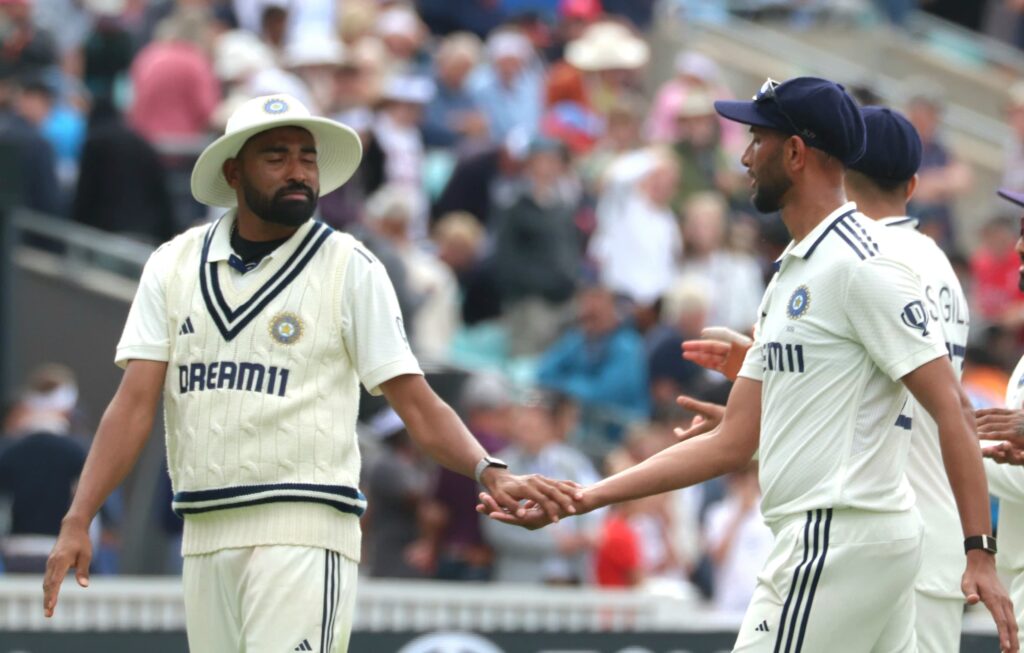
Gargi Raut at The Oval
It was the 71st over, and all hope appeared lost for the Indian team. Harry Brook and Joe Root had done the bulk of the run-scoring and England had only 44 runs left to chase. Prasidh Krishna ran in from the Vauxhall End, tired and battered. In the absence of Jasprit Bumrah, the leader of the pace attack, Mohammed Siraj was to Krishna’s right, fielding at mid-on, the pillar to fall back on in case his junior needed it. While the television screen focused on Prasidh’s dull but determined eyes, running in with the red cherry, what many did not see was that Siraj, outside the camera frame, would rile up the crowd every time his teammate was running in.
The crowd that had witnessed the fall of Brook, a batter whose name now invokes grimaces on the faces of Indian fans, had fallen flat. While the English fans filled the stadium with the low-hum vibrato of “Roooot…”, the Indian fans sat, drinking their beverages and quietly absorbing the loss that seemed closer than ever. In the fourth delivery of the over, a rash charge from Jacob Bethell sent him walking. Hard length outside off, and he danced down, swinging for glory. But the ball took a thick inside edge, snuck through and smashed into middle. The stump lay flat and Bethell’s long walk began. And suddenly the energy at The Oval, standing tall in all its beautiful weirdness, had shifted. The crowd had lit up and suddenly fans who had long lost hope were now asking for a win.
Only an hour earlier, in the final few overs before lunch, India had witnessed a cruel twist of fate. Brook, who was on 19, skied one into the London air. When the ball found the safe hands of India’s pace attack leader, Krishna’s arms were up in the air and the slip cordon had taken off towards the bowler. But what they didn’t know yet was that Siraj, unaware of how close he was to the boundary had stepped on to the rope, lost his balance and was outside the field. Siraj clutched his face in his hands. Around him, the field fell silent. The catch had turned into a maximum.
The same thought echoed around the stadium – “This was the turning point” – and indeed it was. Brook grabbed the opportunity by the throat and stitched a 195-run partnership with Joe Root. He did the bulk of scoring, contributing 111 runs to the partnership. Till he fell to a delivery from Akash Deep, caught by, wait for it…Siraj. But Brook had done the job, and England only needed 73 to win.
That was the second heartbreak that Siraj went through in the series. The first is a memory now been etched in every Indian fan’s mind, a textbook defensive shot from the tailender that saw the ball slowly roll onto the stumps at Lord’s. Siraj, crestfallen, crumbled under the weight of disappointment, crouched at the crease, with his head resting on his bat. India were so close yet so far. He believed that he could be the one to take India over the line, and while he didn’t emerge the hero, he won millions of hearts with his lion-hearted effort throughout the series.
Throughout a long and gruelling series that has seen the highest of peaks and the lowest of valleys, Siraj has been the heartbeat of the team. Among the Indian bowlers, he has bowled the most overs, taken the most wickets and shown more heart than anyone else, over after over. India, battered and wounded, still stand. They need just three more wickets. The new ball is three overs away. Three overs until the red cherry is hard again, biting and dangerous.
There is still a sliver of belief. And at the heart of it, there is Siraj. Tired legs, aching shoulders, lungs burning from the overs he’s already poured out. He’s bowled more than any of his teammates. He’s carried heartbreak after heartbreak. But if there’s a chance, any chance, he’ll want the ball again. Because that’s just who he is. And if there’s one man who will keep fighting until the very last ball, it’s Mohammed Siraj.
How many heartbreaks can he take?
As many as it takes to bring India back.
For More Exciting Articles Follow RevSportz




